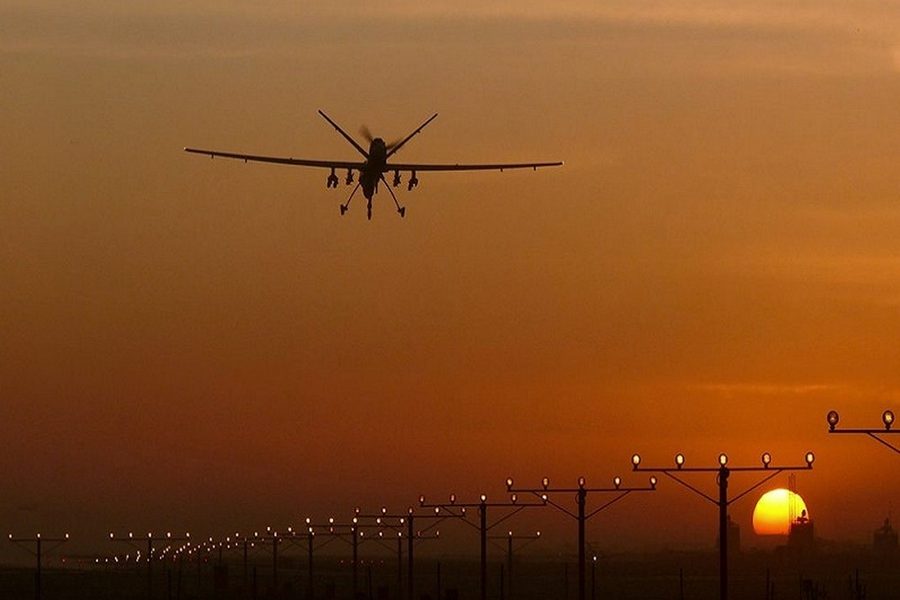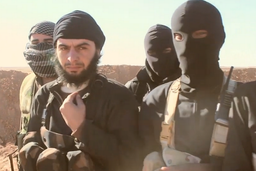Death from Above, Remotely Controlled: Obama’s Drone Wars
History will view drone warfare as the Obama administration’s signature approach to military engagement.
Muhammad Idrees Ahmad

On January 23, 2009, his third day in office, President Barack Obama ordered a drone strike on the small village of Gangi Khel in South Waziristan, a semi-autonomous region along Pakistan’s northwestern frontier. The president, according to journalist Daniel Klaidman, had been briefed by the CIA director Michael Hayden on “the geometry of the operation, the intelligence it was based on, and the risk of collateral damage.” The quarry was a High Value Target (HVT) and the president gave his assent. With laser-guided precision, an AGM-114 Hellfire missile blew up the compound where the target hid. Three hours earlier, another drone had struck a village in North Waziristan.
The attacks killed up to 25 people, but the administration made no public comment. Officially, it maintained a policy of denial: the drone program didn’t exist. And media reports were far from discomfiting. ABC News reported the next day that the strikes had “killed at least eight al Qaeda leaders, including Usama al Kini, planner of the 1998 US embassy bombings in Africa.”
The reality, however, was less seemly. Obama soon learned from Hayden that neither strike had killed its intended target. The “compound” struck by the first drone was the home of 18-year-old student Faheem Qureshi — it killed his cousins and guests, fractured his skull and put out his eye. The second belonged to Malik Gukistan Khan, a pro-government leader of a local peace committee, who perished alongside his nephew and three sons, the youngest aged 3.
The president had drawn first blood — and he wasn’t happy. He quickly convened a meeting of the National Security Council to discuss the implications of these blunders. After consulting his advisors, Obama did what most world leaders do when their expectations are confounded: he doubled down.
The year ended the way it began: on December 17, 2009, a cruise missile packed with cluster munitions (whose use is proscribed in much of the world) slammed into the small Yemeni village of al-Majalah, killing 59, including 21 children and nine women, five of them pregnant.
Yet this kind of remote warfare would become the Obama administration’s signature approach to military engagement. Less than a decade after a US ambassador had chided Israel for its policy of “targeted assassinations” — describing them as “extrajudicial killings” — Obama would not only sanction assassinations, he would take them to another level.
In clear breach of international humanitarian law, the U.S. would expand the use of “signature strikes,” killing people based on remotely observed “patterns of life” rather than actual intelligence. Worse, they would target funerals and first responders, leading UN special rapporteurs to open war crimes investigations against the U.S.
Such lethal tools and authority without strict oversight make abuses inevitable, but the secrecy surrounding the policy has created what Human Rights Watch calls an “accountability blackhole.” Furthermore, the administration has persecuted or defamed those who have tried to uncover the scope and consequences of the program.
When the Yemeni government was on the verge of releasing journalist Abdulelah Haider Shaye, who was arrested for revealing the U.S.’s role in the aforementioned al-Majalah bombing, President Obama personally intervened to dissuade it. When researchers from the Bureau of Investigative Journalism (BIJ) confirmed that drones were killing large numbers of civilians, administration officials tried to paint them as al Qaeda sympathisers.
Obama’s drone policy
President Obama has defended his policy of “very precise precision strikes” as a “targeted focused effort at people who are on a list of active terrorists who are trying to go in and harm Americans, hit American facilities, American bases, and so on.” In a major 2013 speech, he also announced that in response to growing criticism of such strikes, he was narrowing targeting criteria: “Before any strike is taken, there must be near-certainty that no civilians will be killed or injured.”
The gap between administration rhetoric and action, however, remains unbridged. After a drone strike last January accidentally killed western aid workers Warren Weinstein and Giovanni Lo Porto, the administration admitted that it did not know whom it was targeting.
“It has become clear,” the New York Times concluded, “that when operators in Nevada fire missiles into remote tribal territories on the other side of the world, they often do not know who they are killing, but are making an imperfect best guess.” The BIJ calculates that of the nearly 4,000 people killed by drones in Pakistan, fewer than 4 percent were al Qaeda. Only 2 percent were “high value targets.”
Why has the Obama administration embraced a strategy that has yielded so little at such a high cost in prestige? The question confounds many.
Two recent books offer compelling answers. Sudden Justice: America’s Secret Drone Wars is Chris Woods’s meticulous account of the rise of the armed drones, the scope of their deployment, and the humanitarian and political consequences of their use. Andrew Cockburn’s Kill Chain: The Rise of the High-Tech Assassins gives a broader view, situating drones within the long American history of assassinations and the country’s general fascination with lethal technology. Both books lift the veil on the operational and technological sides of this secretive campaign — and cast doubt on their strategic value as a counterterrorism tool.
A substitute for boots on the ground
If there are doubts about the strategic value of drones in fighting terrorism, their political value is beyond reproach. Drone attacks play well domestically.
The U.S. is the only country besides Israel and Kenya where the drone war enjoys majority support by citizens (though, as political scientist Sarah Kreps notes, these figures may have been inflated by poorly formulated survey questions). A successful drone strike earns Obama kudos and shields him from the Republican charge of weakness; an unsuccessful one only angers outsiders, whose disapproval is of little consequence.
Even abroad, people are willing to excuse Obama’s infractions so long as he isn’t launching all-out wars like his predecessor. Indeed, he was rewarded with a Nobel Peace Prize for the sole achievement of not being George W. Bush. And Obama received the prize with suitable contempt: even as he accepted the prize, notes Woods, a drone struck Waziristan, killing six. A week later, Obama would inaugurate a new campaign in Yemen with the assault on al-Majalah.
Killing a large number of people in the hope that some of them might turn out to be terrorists may deliver occasional victories, but it also inflames the sentiments that created the threat in the first place. Research by the human rights organisation Reprieve has shown that the U.S. has killed 28 unknown people for every one of its intended targets. Most of these were killed in Pakistan’s remote FATA region. They posed little or no threat to the U.S. But every innocent that is killed adds to the reservoir of resentment that occasionally overflows in the form of the Tsarnaev brothers, the Boston Marathon bombers, or a Faisal Shahzad, the would-be Times Square bomber.
But where Obama has embraced drones as a convenient substitute for boots on the ground, there is no reason to believe that his approach is somehow unique, or that another leader would have acted differently. As Cockburn notes, the “unswerving faith that the vagaries of conflict can be overcome by technology” has a longer history.
The Manhattan Project and the atomic bomb had reinforced the conviction that technology can dramatically alter the balance of power. But, as Cockburn notes, during the Vietnam War, the U.S. also attempted a fanciful plan to defeat the enemy by building an electronic fence along the infamous Ho Chi Minh trail.
The costly experiment failed as the Vietnamese guerrillas quickly figured out ways to defeat the sensors. But the failure only whetted the appetite of military leaders for better technological fixes. Cockburn quotes a 1969 speech by the commander of the US forces in Vietnam General William Westmoreland that sounds like the wish that drones have answered:
On the battlefield of the future, enemy forces will be located, tracked and targeted almost instantaneously through the use of data links, computer assisted intelligence evaluation, and automated fire control. With first round kill probabilities approaching certainty, and with surveillance devices that can continually track the enemy, the need for large forces to fix the opposition will be less important.
This vision was incorporated into what later came to be known as the Revolution in Military Affairs (RMA), a new approach to warfare that emphasized long-range precision weapons, networked command and control, battlefield surveillance and satellite communications. Cockburn provides a detailed account of the winding path that led up to the RMA, with its myriad prophets, fantastic visions, spectacular failures, inter-agency rivalries and the eventual triumph. It was the 1991 Gulf War that cemented the belief that airpower alone could deliver victory.
Less than precise
But what is true for a conventional war is not nearly as applicable to guerrilla conflict. Technology has doubtless made advances, but the accuracy of a weapon is only as good as the intelligence its targeting is based on. In 1991, with laser-guided precision, the U.S. blew up the Al Amiriya air raid shelter in Baghdad, believing it to be a “command and control” centre. Over 400 civilians were incinerated.
In the drone war, the U.S. has tried to circumvent human intelligence altogether by relying on dubious tools such as social network analysis (SNA), a social science method that focuses on the relations between actors rather than their individual attributes, and “pattern of life” intelligence that picks targets based on remotely observed behavioural patterns instead of actual evidence.
In an infamous incident in Uruzgan, a U.S. drone blew up 23 members of a family based on such “patterns of life” factors as the ablutions that all practicing Muslims carry out ahead of prayers. In other instances, even modes of urinating have been used to determine guilt or innocence.
Likewise, the drone war has shown the limits of social network analysis. In Afghanistan, the NSA has been recording every telephone conversation, and the CIA and JSOC have sometimes used International Mobile Subscriber Identity (IMSI) numbers to track targets. Cockburn describes an incident where, after associating an IMSI with insurgent leader Mohammed Amin, prolonged drone surveillance helped track him down along with five of his companions, leading to a targeted strike.
Except the man they killed wasn’t Amin, but the anti-Taliban leader Zabet Amanullah, along with five of his relatives, one of them 77 years old. The initial intelligence was defective.
Beyond intelligence failures, however, are also pure abuses of authority. Confident of the immunity guaranteed by government secrecy, the CIA and JSOC have been less than cautious in exercising their license to kill.
In one incident in 2009, described by both Cockburn and Woods, the CIA killed Khwaz Wali Mehsud, a mid-level militant, in the hope that the Pakistani Taliban chief Baitullah Mehsud would attend his funeral. Nearly 5,000 people attended the funeral and the CIA duly fired three missiles into it. Eighty-three people were killed, including 10 children — Baitullah wasn’t among them. In another incident, after the American mercenary Raymond Davis was briefly arrested in Pakistan for a double murder, the CIA retaliated by hitting a gathering of pro-government tribal elders, killing 42.
In the latter case, Woods notes, the attack was carried out over the objections of the U.S. ambassador in Islamabad Cameron Munter; he was overruled by CIA director Leon Panetta. Munter wasn’t the first ambassador to be sidelined. His predecessor Anne Patterson’s warnings were also ignored. In a September 23, 2009 cable to Washington, uncovered by Wikileaks, the veteran diplomat had issued a blunt warning:
Increased unilateral operations in these areas risk destabilising the Pakistani state, alienating both the civilian government and military leadership, and provoking a broader governance crisis in Pakistan without finally achieving the goal.
But the administration ignored the advice and, under Panetta, vastly expanded the drone program, confident that the blowback would be borne mostly by others. Since the beginning of the war, Pakistan has lost over 30,000 civilians to terrorist attacks, a large number of them killed in retaliation for U.S. drone strikes.
The drone-industrial complex
These concerns are unlikely to sway political opinion in Washington — in part because drones also represent an unholy nexus of political expediency and commercial opportunity.
Politicians like drones because they don’t have to worry about the potential scandal of soldiers left behind enemy lines. The arms industry likes them because high-tech R&D is a reliable cash cow. The drones may be unmanned, but it takes 168 individuals to keep one aloft for 24 hours, many of whom are employed through private contractors.
While the original Predator was attractive for its low price tag, the per-unit cost of newer drones now exceeds those of planes with a pilot in the cockpit. The Reaper is more expensive than the F-16, Cockburn notes, and twice as likely to crash. The Global Hawk is more expensive than the F-35 and has remained in production even though a 2011 Pentagon test office report declared it “not operationally effective.” Yet despite their increasingly high price, the drones now have a 7,500-strong lobby on the Capitol that will continue to find uses for them.
Neither book, however, is a technophobic jeremiad. Woods makes clear that as a weapon of war, a Predator drone is no worse than an F-16; indeed, potentially a drone, armed with a Hellfire missile, with its limited blast radius, can be a more discriminating weapon. The problem is not so much with their battlefield deployment as with their use as cheap cross-border assassination tools.
But drones do take much away in the way of human judgment. Woods highlights this with a study by Lawrence Lewis of the Center for Naval Analyses who, after analysing classified data from U.S. airstrikes carried out in Afghanistan from mid-2010 to mid-2011, concluded that drone attacks were 10 times more likely to result in civilian casualties than attacks by non-remotely controlled aircraft. Cockburn cites instances in which, during combat operations in Afghanistan, pilots flying A10s showed better judgment in the heat of battle than drone operators did from the safety of their air-conditioned trailers in the Nevada desert.
Drones also place a certain emotional distance between the target and the executioner that seems to make killing easier. The military further eases moral constraints by assigning dehumanizing labels such as MAM (“military-aged males”), which turns a whole category of humans into acceptable targets. The dangers were made dramatically clear in a New York Times revelation that the Obama administration had “embraced a disputed method for counting civilian casualties” that, according to several administration officials, “in effect counts all military-age males in a strike zone as combatants … unless there is explicit intelligence posthumously proving them innocent.”
Cockburn highlights this empathy deficit with the aforementioned Uruzgan incident. Thanks to a subsequent investigation, we have access to the transcripts of the chatter among the operators that preceded the killing of the family. The attitude is not just cavalier; it is callous.
Pilot: Our screeners are currently calling 21 MAMs, no females, and two possible children. How copy?
Jaguar 25: Roger, and when we say children, are we talking teenagers or toddlers?
Sensor: I would say about 12. Not toddlers; something more towards adolescents or teens.
Pilot: Yeah, adolescents.
Apparently satisfied with the assessment that the children were “not toddlers,” drone operators continued with the strike. A little while later, all the “adolescents” were dead.
These deaths weren’t unusual. As Woods notes, in Iraq, the U.S. had set the non-combatant casualty value (NCV) at 30 — i.e., US forces could carry out an operation as long as it killed no more than 30 civilians. For an NCV higher than 30, an attack would require the personal authorisation of the secretary of defence. Cockburn notes that according to General Michael Moseley, then-vice chief of staff of the U.S. Air Force, such authority was sought on at least 50 occasions after the invasion — and not once denied. The first successful attack of the drone war killed Al Qaeda deputy Mohammed Atef along with his seven companions; it also killed 100 others.
Drones: less messy than jail
But nowhere has the administration’s policy been more cynical than in its adoption of assassinations as a less messy alternative to detention. On several occasions, according to Woods (and corroborated by journalists Mark Mazzetti and Daniel Klaidman), the administration has avoided the political complications of detaining terrorism suspects by having them killed instead.
As a former law professor, Obama is perhaps conscious that the Geneva conventions forbid torture under any circumstances but permit killing in war. Killing is his way of pre-empting fraught questions of detention, jurisdiction and torture.
But Woods reveals an even more disturbing reality: “One former officer with ISAF later recounted for the author an incident in which an Afghan suspected insurgent was being held in custody. It was decided that, while there was not enough evidence to hold the man, there were suitable grounds to assassinate him.”
The CIA, Woods argues, implicated the administration in its assassination policy early, making it impossible for it to disavow it without incriminating itself. But if the CIA is cynical, the administration is hardly blameless. Bush had restored the CIA’s license to kill, but Obama formalized and expanded it.
‘Never seen, never known, never hated’
In their different ways, Woods and Cockburn have made important contributions to a subject that is otherwise mired in secrecy, disinformation and polemical excess. To be sure, Cockburn has sharp polemical chops, but his witticisms don’t come at the expense of facts. He takes a more historically informed view and adds substantial original reporting to it.
Woods, by contrast, takes a more focused approach: His book is perhaps the most comprehensive and scrupulous treatment of the subject. (Though it also is overly cautious, sometimes to a fault. For example, on the two occasions he mentions casualties of the Iraq War, he ignores extensive peer-reviewed surveys in favour of the methodologically dubious, establishment-friendly Iraq Body Count figures).
For students of the subject, both books are indispensable; but for citizens concerned with the political and humanitarian consequences of the drone war, Woods, with his systematic approach, will prove more useful.
Meanwhile, as the U.S. monopoly on drones slips, the menace is likely to grow. Benjamin Netanyahu has already embraced U.S. rationales in carrying out drone strikes in Gaza and overseas in the Sinai and the Sudan. But the tortured rationales that were offered for U.S. drone assassinations will look even less convincing once a leader like Vladimir Putin adopts them.
It is perhaps time to visit the warning (quoted by Cockburn) that Vietnam War veteran Eric Herter had issued at an anti-war soldiers’ meeting in Boston long before the age of drones:
The new forms of war that are to replace the unpopular struggle of infantry and patrol against guerrilla bands … This new war will not produce My Lais. It will be a war not of men at arms, but of computers and weapons systems against whole populations. Even the tortured bond of humanity between enemies at war will be eliminated. Under its auspices, the people of the villages have gone from being “gooks” and “dinks” to being grid-coordinates, blips on scan screens, dots of light on infrared film. They are never seen, never known, never even hated. … It is hard to feel responsible for this type of war, even for those who were close to it. There is little personal involvement. The atrocity is the result of a chain of events in which no man plays a single decisive part.”
With decision-making obscured by procedural secrecy, and with public censure pre-empted by disinformation, moral constraints on killing are lifted. The act of killing becomes casual, even banal. Responsibility is deferred. If there is any lesson to be drawn from these books, it’s that transparency is the necessary first step to repairing chains of responsibility and ensuring accountability.





